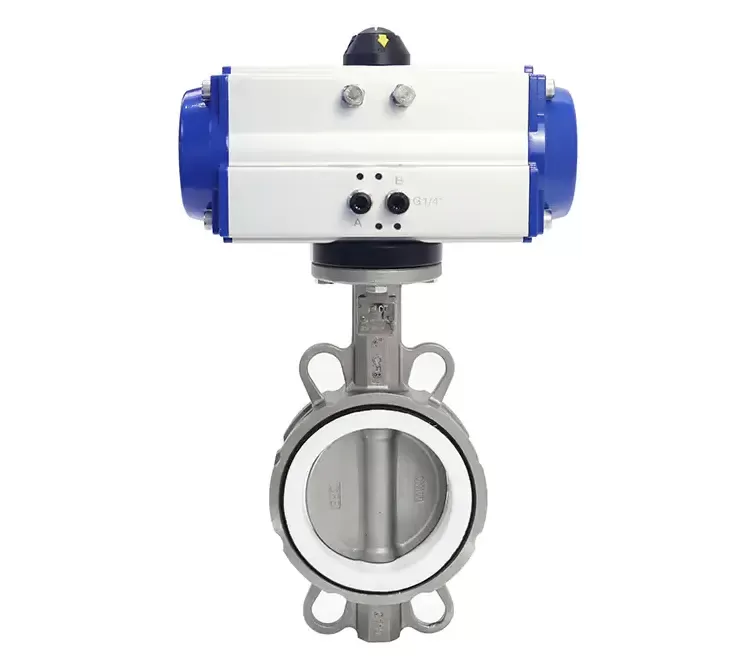Notifications

7 minutes, 50 seconds
-15 Views 0 Comments 0 Likes 0 Reviews

Introduction
Pneumatic wafer butterfly control valves have become an essential component in a wide range of industries due to their efficient flow control, compact design, and ease of operation. These valves are favored for their lightweight construction, rapid response times, and reliability, making them ideal for applications ranging from chemical processing to water treatment.
This article provides an in-depth look at the structure, key features, industry applications, installation procedures, and maintenance best practices for pneumatic wafer butterfly valves. By the end, you'll have a comprehensive understanding of why these valves are crucial in modern fluid control systems.
What Are Pneumatic Wafer Butterfly Valves?
Pneumatic wafer butterfly valves consist of two primary components: a pneumatic actuator and a butterfly valve body. The term "wafer" refers to the installation method, where the valve is sandwiched between two flanges in the pipeline, secured by bolts passing through both the flanges and the valve body.
When compressed air enters the actuator, it rotates the valve stem, which in turn moves the butterfly disc inside the valve body. Depending on the disc's rotation angle, the valve either opens, throttles, or closes the fluid flow.
This design offers fast opening and closing, precise flow regulation, and seamless integration with automated systems, making pneumatic wafer butterfly valves a cornerstone of modern industrial fluid control.
Key Features of Pneumatic Wafer Butterfly Valves
Compact and Lightweight Design
These valves are lightweight and easy to transport, install, and maintain. Their minimalistic design also reduces the load on piping systems and support structures.
Easy Installation and Maintenance
Thanks to their wafer design, these valves can be installed quickly with fewer bolts compared to lug-type valves, resulting in faster assembly and straightforward maintenance.
Simple and Efficient Structure
The valve comprises a few key parts, reducing complexity and failure points, ensuring reliability and efficiency in operation.
Low Operating Torque
The aerodynamic butterfly disc reduces resistance, which minimizes the torque required to operate the valve. This enables smaller actuators and faster response times.
Quick 90° Rotation
These valves feature a 90-degree rotation from fully open to fully closed, making them ideal for systems requiring rapid cycling and minimizing downtime.
Excellent Flow Characteristics
When fully open, pneumatic wafer butterfly valves offer minimal pressure loss and good throttling capabilities when partially open, ensuring precise flow control.
Pinless Connection Between Disc and Stem
The pinless connection between the valve disc and stem eliminates potential leakage points, improving valve integrity and extending service life.
Spherical Disc Profile
The spherical shape of the valve disc enhances sealing performance, providing a more uniform seal and reducing wear on the seat.
Replaceable Sealing Components
Seals and seats can be replaced individually, which extends the valve’s lifespan, reduces maintenance costs, and ensures reliable performance.
Coating Options
The valve disc can be coated with materials like PTFE or nylon for improved chemical resistance, reduced friction, and enhanced sanitation in food-grade applications.
Versatile Connection and Operation
Pneumatic wafer butterfly valves can be configured with wafer or flange connections and can be operated manually, electrically, or pneumatically, offering flexibility for different automation and control needs.
Applications Across Industries
Pneumatic wafer butterfly valves are highly versatile and widely used in various industries:
Chemical Processing
Used to control corrosive or hazardous fluids, these valves provide reliable sealing and durability in harsh environments.
HVAC Systems
In HVAC systems, they efficiently regulate air and water flow, improving energy efficiency and indoor climate control.
Water Treatment Plants
These valves help manage the flow of water in treatment facilities, ensuring proper distribution and wastewater management.
Food and Beverage Industry
With materials like PTFE, they offer sanitary, contamination-free handling of liquids in food and beverage processing.
Pharmaceutical Manufacturing
The valves are designed to meet strict hygiene standards, offering precise fluid control in pharmaceutical production.
Pulp and Paper
They regulate the flow of chemicals, water, and slurry in pulp and paper mills, providing durability in abrasive environments.
Installation and Maintenance Tips
Installation Tips:
Pipeline Preparation: Ensure flanges are properly aligned before installing the valve to prevent leakage and stress.
Component Inspection: Verify that the valve components, including the actuator and connections, are intact and clean before installation.
Correct Positioning: Position the valve in the closed position before connecting it to ensure proper alignment.
Secure Fastening: Use appropriate bolts to securely fasten the valve, ensuring uniform torque across the flange and valve body.
Commissioning and Debugging:
Air Pressure Check: Ensure the air supply is at the correct pressure (typically 0.4 to 0.6 MPa).
Manual Operation: Test the valve manually to ensure proper operation during initial testing.
Stroke Adjustment: Fine-tune the actuator's stroke if there’s resistance in the opening or closing cycle.
Smooth Operation: Ensure the valve opens and closes smoothly, with no binding or leakage.
Maintenance Tips:
Routine Inspections: Regularly check the seals, actuator, and other components for wear or contamination.
Lubrication: Periodically lubricate moving parts to ensure smooth operation.
Seal Replacement: Replace seals and seats as needed to prevent leakage and ensure optimal performance.
Actuator Maintenance: Inspect pneumatic actuators for leaks and irregular performance, and clean air supply lines regularly.
Documentation: Maintain detailed service records to track maintenance and extend valve life.
Conclusion
Pneumatic wafer butterfly valves are a highly efficient, reliable, and flexible solution for various industrial applications. Their compact design, low operating torque, quick rotation, and excellent flow control characteristics make them a top choice in industries such as chemical processing, water treatment, HVAC, and food processing.
Proper installation, routine maintenance, and careful commissioning are crucial for ensuring these valves operate at peak performance throughout their service life. By selecting high-quality valves and following best practices for installation and maintenance, you can maximize their longevity and optimize the overall performance of your fluid control system.Know more about Google SEO Directory

